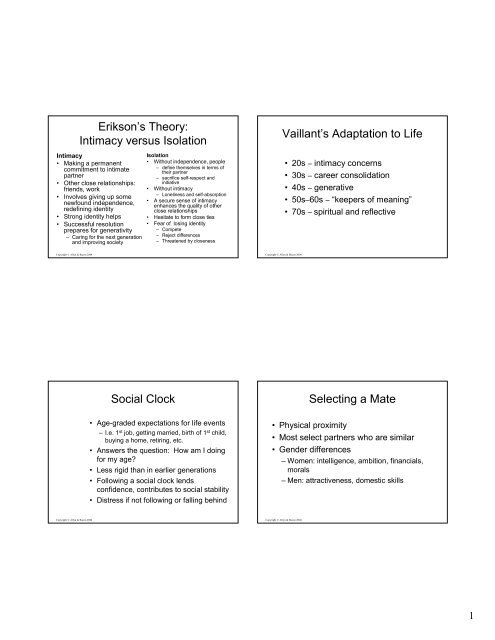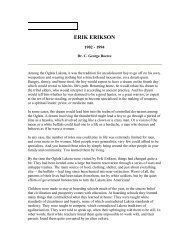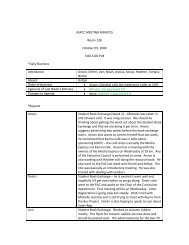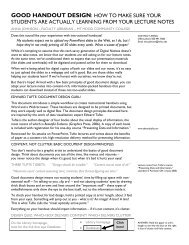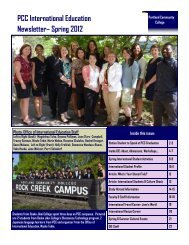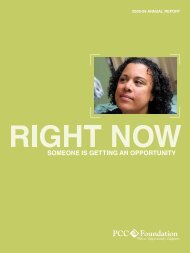Erikson's Theory: Intimacy versus Isolation Vaillant's Adaptation to ...
Erikson's Theory: Intimacy versus Isolation Vaillant's Adaptation to ...
Erikson's Theory: Intimacy versus Isolation Vaillant's Adaptation to ...
Create successful ePaper yourself
Turn your PDF publications into a flip-book with our unique Google optimized e-Paper software.
Copyright © Allyn & Bacon 2004<br />
Erikson’s <strong>Theory</strong>:<br />
<strong>Intimacy</strong> <strong>versus</strong> <strong>Isolation</strong><br />
<strong>Intimacy</strong><br />
• Making a permanent<br />
commitment <strong>to</strong> intimate<br />
partner<br />
• Other close relationships:<br />
friends, work<br />
• Involves giving up some<br />
newfound independence,<br />
redefining identity<br />
• Strong identity helps<br />
• Successful resolution<br />
prepares for generativity<br />
– Caring for the next generation<br />
and improving society<br />
Copyright © Allyn & Bacon 2004<br />
Social Clock<br />
<strong>Isolation</strong><br />
• Without independence, people<br />
– define themselves in terms of<br />
their partner<br />
– sacrifice self-respect and<br />
initiative<br />
• Without intimacy<br />
– Loneliness and self-absorption<br />
• A secure sense of intimacy<br />
enhances the quality of other<br />
close relationships<br />
• Hesitate <strong>to</strong> form close ties<br />
• Fear of losing identity<br />
– Compete<br />
– Reject differences<br />
– Threatened by closeness<br />
• Age-graded expectations for life events<br />
– I.e. 1 st job, getting married, birth of 1 st child,<br />
buying a home, retiring, etc.<br />
• Answers the question: How am I doing<br />
for my age?<br />
• Less rigid than in earlier generations<br />
• Following a social clock lends<br />
confidence, contributes <strong>to</strong> social stability<br />
• Distress if not following or falling behind<br />
Vaillant’s <strong>Adaptation</strong> <strong>to</strong> Life<br />
• 20s – intimacy concerns<br />
• 30s – career consolidation<br />
• 40s – generative<br />
• 50s–60s – “keepers of meaning”<br />
Copyright © Allyn & Bacon 2004<br />
Copyright © Allyn & Bacon 2004<br />
• 70s – spiritual and reflective<br />
Selecting a Mate<br />
• Physical proximity<br />
• Most select partners who are similar<br />
• Gender differences<br />
– Women: intelligence, ambition, financials,<br />
morals<br />
– Men: attractiveness, domestic skills<br />
1
Childhood Attachment and Adult<br />
Romantic Relationships<br />
Attachment<br />
His<strong>to</strong>ry<br />
Secure<br />
Avoidant<br />
Resistant<br />
Copyright © Allyn & Bacon 2004<br />
Same-Sex<br />
Friendships<br />
Copyright © Allyn & Bacon 2004<br />
Working Model<br />
Comfortable with<br />
intimacy; unafraid of<br />
abandonment<br />
Stress<br />
independence,<br />
mistrust, anxiety<br />
about closeness<br />
Seek quick love,<br />
complete merging<br />
Adult Relationships<br />
Trust, happiness,<br />
friendship<br />
Jealousy, emotional<br />
distance, little physical<br />
pleasure<br />
Jealousy, desperation,<br />
emotional highs & lows<br />
Gender and Friendship<br />
• Gender differences<br />
– Women’s more<br />
intimate<br />
• Individual differences<br />
– Longer friendships<br />
more intimate<br />
– Single people more<br />
intimate with friends<br />
Other-Sex<br />
Friendships<br />
• Fewer, shorter-lasting<br />
than same-sex<br />
– Educated, employed<br />
women have most<br />
• Benefits <strong>to</strong> both genders<br />
– Men: opportunity for<br />
expression<br />
– Women: new views<br />
• Sexual attraction must be<br />
considered<br />
Sternberg’s Triangular <strong>Theory</strong> of Love<br />
• 3 components:<br />
– <strong>Intimacy</strong>: emotional component<br />
– Passion: physical and psychological component<br />
– Commitment: cognitive component<br />
• leads <strong>to</strong> decision <strong>to</strong> love and maintain love<br />
• Passionate love (sexual attraction) is strong at the<br />
beginning of a relationship, but then transitions <strong>to</strong><br />
companionate love (warm, trusting affection and<br />
caregiving). Commitment determines whether a<br />
relationship survives.<br />
Copyright © Allyn & Bacon 2004<br />
Copyright © Allyn & Bacon 2004<br />
Fac<strong>to</strong>rs in Loneliness<br />
Unhappiness resulting from a gap between relationships we have and those<br />
we desire<br />
Age<br />
Circumstances<br />
Personal<br />
Characteristics<br />
• Peaks in late teens, early 20s<br />
• Declines through 70s<br />
• Separated, divorced, widowed<br />
• Immigrants from collectivist cultures higher than<br />
those born in US or Canada<br />
• Socially anxious<br />
• Insecure models of attachment<br />
• Self-defeating behaviors, attitudes<br />
6<br />
2
• Early adulthood<br />
– Leaving home<br />
– Joining families in<br />
marriage<br />
– Parenthood<br />
• Middle adulthood<br />
– Launching children<br />
• Sequence of phases that<br />
characterizes<br />
development of most<br />
families<br />
Copyright © Allyn & Bacon 2004<br />
Family Life Cycle<br />
• Late adulthood<br />
– Retirement<br />
– Death of spouse<br />
Gender Differences in Marital<br />
Satisfaction<br />
Men: Just being married improves<br />
physical and mental health<br />
– Attachment, belonging, social support<br />
Women: Relationship quality is<br />
important<br />
– Overwhelming demands of many roles<br />
cause dissatisfaction<br />
Copyright © Allyn & Bacon 2004<br />
Fac<strong>to</strong>rs Related <strong>to</strong> Marital<br />
Satisfaction<br />
• Family backgrounds<br />
• Age at marriage<br />
• Length of courtship<br />
• Timing of first pregnancy<br />
• Relationship <strong>to</strong> extended family<br />
• Financial and employment status<br />
• Family responsibilities<br />
• Personality characteristics<br />
Copyright © Allyn & Bacon 2004<br />
Copyright © Allyn & Bacon 2004<br />
Transition <strong>to</strong> Parenthood<br />
• Many profound changes<br />
• Roles often become more traditional<br />
– Roles get less traditional with second birth<br />
• Marriage can be strained<br />
– Problems before children predict problems<br />
after<br />
– Sharing care predicts happiness<br />
• Later parenthood eases transition<br />
– Couple’s groups, paid leave help, <strong>to</strong>o<br />
3
Copyright © Allyn & Bacon 2004<br />
Parenting<br />
• Powerful source of adult development<br />
• With young children<br />
– Best parents work <strong>to</strong>gether as co-parenting<br />
team<br />
– Challenges: few social supports; hard <strong>to</strong> find<br />
child care<br />
• With adolescents<br />
– Brings sharp changes<br />
– Challenges: negotiation of roles,<br />
dip in marital satisfaction<br />
Copyright © Allyn & Bacon 2004<br />
Divorce Rates<br />
• Stabilized since 1980s<br />
• 45% U.S., 30% Canadian marriages<br />
– About 7% higher for remarriages soon after first<br />
marriage<br />
• First seven years, midlife<br />
most common times<br />
– Young and adolescent<br />
children involved<br />
Copyright © Allyn & Bacon 2004<br />
Cohabitation<br />
• Unmarried, sexually intimate, living<br />
<strong>to</strong>gether<br />
• Increasing<br />
• Can be preparation for marriage<br />
– North Americans who cohabit<br />
before marriage more likely <strong>to</strong><br />
divorce<br />
• Can be alternative <strong>to</strong> marriage<br />
– More accepted in Western Europe<br />
Causes and Fac<strong>to</strong>rs in Divorce<br />
• Ineffective problem solving<br />
• Separate lives<br />
• Major problems: Infidelity, money issues,<br />
substance abuse<br />
• Background fac<strong>to</strong>rs: age,<br />
religion, prior divorce, family<br />
background<br />
• SES<br />
• Gender roles, expectations<br />
Copyright © Allyn & Bacon 2004<br />
4
Copyright © Allyn & Bacon 2004<br />
Consequences of Divorce<br />
• Major change of life and self<br />
– Opportunities for positive and negative change<br />
• Immediate consequences - generally subside<br />
in 2 years<br />
– Disrupted social networks, support<br />
– Increased anxiety, depression, impulsive behavior<br />
– Traditional women, noncus<strong>to</strong>dial fathers may<br />
have more problems<br />
• New partner helps satisfaction<br />
– More important <strong>to</strong> men<br />
Challenges <strong>to</strong><br />
Women’s Career Development<br />
• Discontinuous employment<br />
– Leave for child-rearing, family care<br />
– Hinders advancement<br />
• Concentration low-paying, low-advancement<br />
jobs<br />
– Contributes <strong>to</strong> salary gap<br />
• Low self-efficacy for male-dominated fields<br />
• Gender stereotyping<br />
• Few men<strong>to</strong>rs<br />
Copyright © Allyn & Bacon 2004<br />
Copyright © Allyn & Bacon 2004<br />
Remarriage After Divorce<br />
• Most within four years of divorce<br />
– Men sooner than women<br />
• Vulnerable <strong>to</strong> breakup<br />
– Reasons for marriage<br />
• Often <strong>to</strong>o pragmatic<br />
– Carry over negative patterns<br />
– View divorce as acceptable resolution<br />
– Stepfamily stress<br />
• Takes 3-5 years <strong>to</strong> blend<br />
– Education,<br />
couples and family counseling can help<br />
Copyright © Allyn & Bacon 2004<br />
Work-Family Balance<br />
• Dual-earner marriages dominant family<br />
form<br />
– Most also parents<br />
• Role overload common problem<br />
– Especially for women<br />
• Workplace supports can help<br />
– Time flexibility<br />
5


